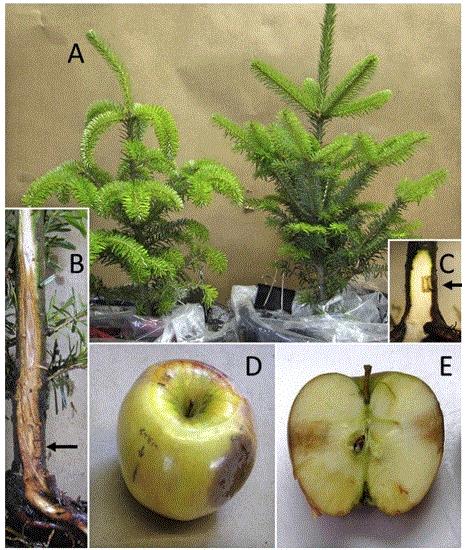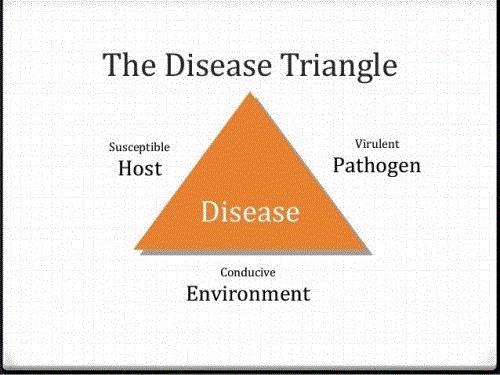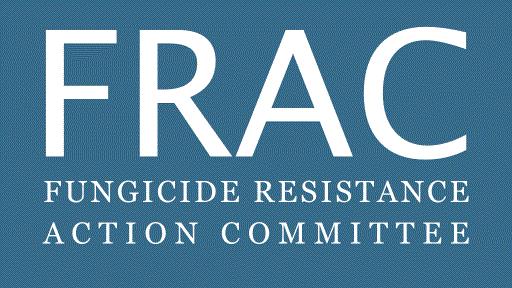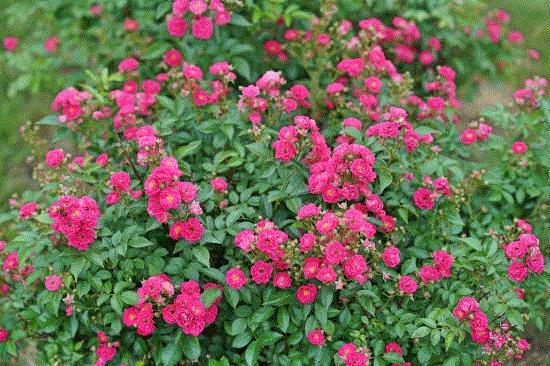New Fraser Fir Pathogen Described
It’s always interesting to read about newly identified species, albeit a bit more sobering when these are new plant pathogens or insect pests. Recently, a study published in Plant Disease described a new species of phytophthora (Phytophthora abietivora) that seems to be particularly damaging to Fraser fir (Abies fraseri). While this study specifically investigated the pathogen in relation to Christmas tree farms, we all know that Frasier fir is also used extensively in the northern U.S., Canada and even Northern Europe as a landscape tree. Therefore, I wanted to share with you this "new" plant pathogenic species, as it may come to a landscape or nursery near you soon.

Representative potted Abies fraseri and inoculated apples used to test Koch’s Postulates. (A) Inoculated (left) and uninoculated control (right) fir trees at 17 days post inoculation. The location of the bark flaps, marked with arrows, shows interior discoloration in lesions extending from the inoculation site in (B), but not in the stem of the uninoculated control tree (C). Brown discoloration of the flesh of an apple (D) developed about two weeks after inoculation with infected tissue taken from the roots (right side), but not when taken from the upper margin of the lesion on the stem (left side). The bisected apple (E) shows brown discoloration developing from inoculation slits made on opposite sides of the same apple, both originating from infected root tissue. Published in: De-Wei Li; Neil P. Schultes; James A. LaMondia; Richard S. Cowles; Plant Disease 2019, 103, 3057-3064. Copyright © 2019 The American Phytopathological Society • DOI: 10.1094/PDIS-03-19-0583-RE
What’s troubling about this newly identified species is that it appears to be highly pathogenic—meaning it's very effective at infecting and killing trees. It also kills them quickly (symptoms appeared an average of 26 days after inoculation), which is both good and bad.
Obviously, if it affects a landscape tree and kills it in a month, that’s harsh. However, it also affords growers and buyers of Frasier fir the opportunity to relatively quickly determine if trees bought are infected. To do so, simply quarantine trees purchased for 60 days (I know, easier said than done) with no fungicide applications. Most fungicides will prevent sporulation at most 30 days and symptoms should appear within 30 days after the fungicide wears off if the tree is infected. So, if a fungicide was applied on the day of shipment, at 60 days you should know if that tree is infected (it will show symptoms).
There is one exception—the tree needs to be actively growing in order to make this determination. So if you receive plants in winter you'll need to wait longer in quarantine to determine if plants are infected.
But wait—moving a few sentences back to the italicized text—did you think a fungicide could cure an infected plant? If so, think again …

Fungicide—A Somewhat Bogus Word
Here comes the professor (apologies—blame my superiors), but have no fear as the lesson will be easily understood. Despite my background in plant pathology in agronomic crops, I consulted with Dr. Jean Williams-Woodward to make sure things were clear in my mind. Jean is not only one of the best ornamental plant pathologists in the U.S., but also a rare bird in that she describes things in an easily understood manner.
Jean always starts her lecture on plant pathogens to my Nursery Management class at the University of Georgia by defining fungicide, which is critical in understanding how they work (or don’t work). To understand fungicides, you must start with the root meaning of fungicide. The prefix in this Latin term is "fungi," which literally means "a mushroom." The suffix "cide" means "to kill." As a result, so many of us think that a fungicide kills plant pathogens and therefore can cure an infected plant.
That's almost always bogus. The vast majority of fungicides don’t kill a plant pathogen once it's infected a plant. They prevent the spread of a fungus after infection of the plant by controlling sporulation of fungal bodies, growth of hyphae, etc. In simple terms, they stop the growth and reproduction of a plant pathogen. They do not cure an infected plant, as the name fungicide suggests.

Fungistatic—A Better Term
Let’s take a quick trip back to the languages of our ancestors. Remember that the Latin prefix "fungi" literally means "a mushroom." The suffix (in this case) "static" is Greek (from "statikos") meaning "causing to stand." So "fungistatic" would mean to make a plant pathogen stand (still). The pathogen is neither dying nor progressing—it’s just hanging out waiting to throw darts.
This is actually a much better description of how the majority of fungicides affect plant pathogens once a plant has been infected. Fungicides don’t cure (as in the Latin "cide") a plant. Rather, they cause a plant pathogen that's infected a plant to "stand"—or not progress. This means a plant pathogen (depending on the fungicide used) will not sporulate and subsequently cause infections in other plants (or other parts of the same plant).
In the case of systemic fungicides, they're able to stop the spread of infection in an infected plant. However, these systemic products don't cure the plant, nor does damaged plant tissue recover from infection. Furthermore, once the systemic fungicide has worn off, the plant pathogen can resume its progress, given that environmental conditions exist for pathogen growth. This includes sporulating, which can cause neighboring plants to become infected and spread the pathogen in the infected plant.

Understanding Fungicide Terms
So what terms should you understand and look for in fungicide labels and other publications? Here are three terms you should understand:
-
Preventative. This is a product that prevents sporulation of a plant pathogen on the plant surface, be it on the leaf (if applied to foliage), bark/trunk or on roots (if applied as a drench). Preventatives greatly reduce sporulation that hopefully reduces infection. In nursery production, these products are generally applied on a calendar basis and based on the label recommendation for days between treatments. Also, you need to rotate modes of action based on FRAC codes (see below) to avoid resistance of pathogens to a single mode of action.
-
Curative. This is an interesting intermediate generally reserved to active ingredients in the strobilurin and triazol classes of fungicides, in that it's curative only when applied hours to days after infection occurs. The issue is how do you know when infection occurs (unless you're the proud owner of a diagnostic lab)? Nonetheless, depending on the pathogen and crop, these products can actually cure a plant in the hours to several days after infection occurs. It's important to know, though, that curative doesn't apply after symptoms appear. At that point, the plant is infected and will always harbor the pathogen (if it's a systemic pathogen—which most are).
-
Eradicant. In one case, the active ingredient piperalin is described as an eradicant for powdery mildew. But again, this is a bit of a misnomer. Piperalin will kill the fungal pathogen and spores from the plant surface, but doesn't cure the plant of the pathogen once it's infected. Once environmental conditions return that favor powdery mildew development, the plant will again exhibit symptoms and provide an inoculum source via sporulation from the leaf surfaces. At this point, further treatment will be required.

The Disease Triangle
With all of the doomsday news above, one thing is certain: fungicides (statics) play a critical part in successful Integrated Pest Management (IPM) strategies. This is mainly because they play an integral part in the principle of sanitation or reducing pathogen presence (specifically spores of the pathogen) from landscape and/or production areas.
The simple fact that most fungicides prevent sporulation of plant pathogens is extremely important in reducing inoculum that subsequently reduces infection. This is one side of the all-important disease triangle—reducing and/or eliminating the pathogen.

So while you may be wondering why I seemingly trashed fungicides above (not my intention), the use of fungicides has played an amazing role in breaking the disease triangle, which requires all three sides be present in order to see significant infection and death of plants. This exercise in thought was more to encourage you to learn more about how fungicides work and how you can incorporate them into your landscape contracting and/or nursery operation to break that side of the disease triangle.

The FRAC
Just as important as understanding the disease triangle is understanding FRAC (Fungicide Resistance Action Committee) codes. You can make your own acronym meaning (which is entertaining in my undergraduate class), but when it comes down to the basics, FRAC codes ensure our fungicides will continue to be effective moving forward.

The Fungicide Resistance Action Committee is a group of researchers and industry members, across commodities, that "work to prolong the effectiveness of fungicides liable to encounter resistance problems and to limit crop losses should resistance appear."
The basic premise of this group’s efforts is to educate growers of specialty crops, as well as landscape contractors and arborists on the value of rotating fungicide modes of action (MOA) when applying these chemicals to production and/or landscape environments. Each mode of action (chemical/physiological means by which the chemical suppresses the fungus) should be part of a fungicide rotation that incorporates at least three FRAC numbers/codes.
And never forget that any fungicide program requires correct pathogen identification. Why? Because if you don’t know the pathogen, then you cannot treat properly!

Oso Easy Peasy Rose
While you may be sick and tired of learning about plant pathogens, I wanted to cover just one more aspect (side) of that disease triangle—known as host plant resistance. Host plant resistance simply means that the cultivar doesn't succumb to the pathogen (or insect), often the result of genetic tolerance of the pathogen. This is the future of ornamental plant breeding, according to many academic and corporate breeders.

Photo courtesy of Proven Winners.
That brings me to the winner of the American Rose Society Award of Excellence in the No Spray Division, Oso Easy Peasy Rose (developed by David Zlesak and sold under the Proven Winners brand). This petite rose cultivar (3.5-ft. rounded form) produces medium to deep pink flowers continuously that don't rerquire deadheading, and as its award from the prestigious ARS attests, it exhibits outstanding disease resistance (to black spot and powdery mildew in particular). Even better, as a full-sun shrub rose, it's Hardy to Zone 4 (and down to 9).
I hope this plant pathology lesson has been educational and entertaining! If you have another topic that you would like covered in the future, just let me know.

Boxwood Health Workshop
For those of you in the Pacific Northwest, the Horticulture Research Institute (HRI) and Oregon Association of Nurseries (OAN) are planning to bring you a full day of seminars (on February 4, 2020) with experts from around the nation discussing Boxwood Blight best management practices. Designed to educate growers, each session will provide the attendees with the latest research and give them actionable tactics to implement. The cost is $50 and includes lunch. Registration is required; space is limited to 50 people.
Located at the Oregon State University North Willamette Research and Extension Center in Aurora, Oregon, the Boxwood Health Workshop will begin at 8:00 a.m. and end at 4:00 p.m. with six distinct sessions. Speakers include an expert from a major boxwood producer, university ag research facilities, the USDA, the Oregon Department of Agriculture and APHIS.
Specific topics include the latest updates on cultivar testing and control strategies for Boxwood Blight, sanitation tactics and an overview of the nursery production survey implemented by the ODA. For more information and to register for the event, visit: https://www.americanhort.org/page/boxwood-health-workshop.
Our Wacky Wonderful World —Notes from the Edge of Sanity
As Christmahanakwanzika is upon us I wanted to take the time to give thanks to all of you, who not only read Nursery & Landscape Insider, but work your tails off to beautify this big ole’ goofy world. I hope each of you get to take some time off to do something other than work.
See you in 2020!
Live authentic,

Matthew Chappell
Editor-at-Large
Nursery & Landscape Insider
This has been received by 27,440 of the hardest-working horticulturists in show business!
If you're interested in reaching 27,440 (and growing) clients who eagerly await every Nursery & Landscape Insider and surely read every word, contact Kim Brown ASAP and she'll hook you up.